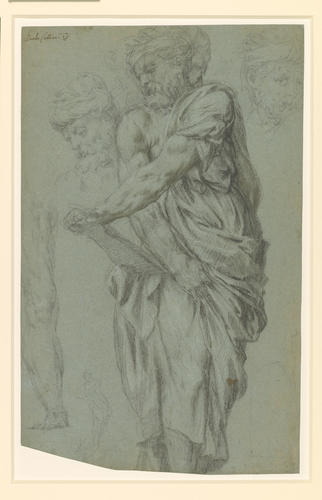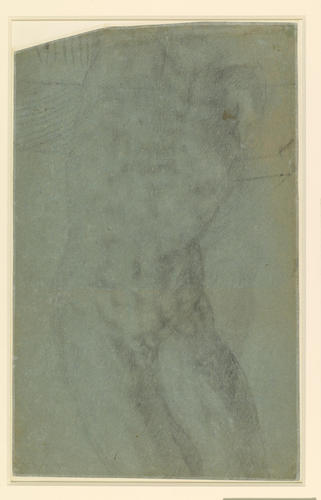A prophet or philosopher c.1557
Black and white chalks with grey-brown wash, on blue paper | 40.8 x 25.4 cm (sheet of paper) | RCIN 906697
-
A study of a standing bearded figure, with two studies of his head in different positions and studies of a leg. Inscribed in an old hand, 'Paulo Calliari. VE' (ie Veronese). On the verso, a large study of the torso and upper legs of a male nude, the rest of the figure cut by the edges of the sheet.
As the inscription (probably English, of the early seventeenth century) shows, the drawing was traditionally attributed to Paolo Veronese (1528-88). This was tentatively accepted by A.E. Popham (in P&W), and more enthusiastically by W.R. Rearick, who put forward at different times two hypotheses for the purpose of the drawing - an early idea for one of Veronese’s frescoed prophets high in San Sebastiano, Venice (Biblioteca di Disegni. Maestri veneti del Cinquecento, Florence 1976-80, p.54); or connected with Veronese’s work in the Libreria Marciana (The Art of Paolo Veronese, Washington DC 1988, nos. 22-24). In this second publication Rearick advanced a scenario whereby Veronese produced four canvases in 1557, with another planned in the Windsor drawing, continuing the theme of the tondi painted (by artists including Veronese) in the ceiling, with a mixture of philosophers, scientists and allegories; it then became clear that the canvases were too small, and the decision was taken to abandon the first series and commission larger canvases with the figures in architectural niches designed by Sansovino himself. An attribution of the drawing to Veronese was accepted by X. Salomon (verbally, 2023), as an early study for one of the niche figures in the Libreria.
In rejecting the drawing as Veronese's, R. Cocke (Veronese's Drawings, London 1984, p.387) argued that ‘the detail with which the shadow is built up and the insistence on the silhouette achieve a powerful sculptural effect at odds with Veronese’s painterly chalk studies’. In response Rearick argued that the drawing belonged to a ‘transitional moment’, arguing that Veronese early in his career ‘remained deeply rooted in the Emilian principles that had first inspired him’ ('Black chalk drawings by Paolo Veronese', Master Drawings, 1992, p.148).
H. Sueur proposed an alternative attribution to Veronese’s compatriot Domenico Brusasorci (Le dessin à Verone, Louvre 1993, pp. 64-5, citing an earlier attribution to Brusasorci by P. Pouncey, on the reverse of the old mount). Brusasorci’s drawn oeuvre is very sparse, and few sheets can be assigned to him with certainty; a drawing in Edinburgh, inscribed with the date 1547 and reasonably attributed to the artist, displays the Emilian roots of his eclectic style (The Age of Titian. Venetian Renaissance Art from Scottish Collections, Edinburgh 2004, no. 93). The key work in reconstructing his drawn oeuvre, a study at Chatsworth for his altarpiece of the Madonna and Child with Saints in Sant’Eufemia, Verona, demonstrates a less decorative approach to drapery, with a busy silhouette and stocky figures (M. Jaffe, The Devonshire Collection of Old Master Drawings, 1994, no. 745). The Windsor drawing was accepted as Brusasorci's in L. Whitaker and M. Clayton, The Art of Italy in the Royal Collection, 2007, no. 86.
When the drawing was lifted from its old mount for the Veronese exhibition in Washington in 1988, an unusually large black-chalk drawing of a male nude was discovered on the verso. Too much of the chalk has been lost over the centuries to assess its style. The arms of the figure appear to be missing (as if it were a damaged sculpture), or pinioned or tied behind its back. This is the plight of St Sebastian in Brusasorci’s Sant’Eufemia altarpiece, though the pose of the figure is not particularly close.
Provenance
Listed in George III's Inventory A, c.1810, p. 59, 'Titiano Paolo Veronese e Scuola Veneziana', among '29 to 42. Of Paolo Veronese and Carlo Cagliari'.
-
Creator(s)
-
Medium and techniques
Black and white chalks with grey-brown wash, on blue paper
Measurements
40.8 x 25.4 cm (sheet of paper)
Object type(s)
Subject(s)
Other number(s)










